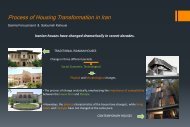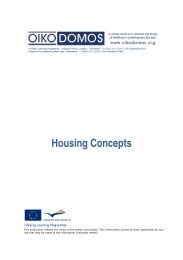Ali Akbar Rahimian Mashhad - Oikodomos
Ali Akbar Rahimian Mashhad - Oikodomos
Ali Akbar Rahimian Mashhad - Oikodomos
You also want an ePaper? Increase the reach of your titles
YUMPU automatically turns print PDFs into web optimized ePapers that Google loves.
EASTERN MEDITERRANEAN UNIVERSITY<br />
Housings by the participation of<br />
low-income people and government<br />
in <strong>Mashhad</strong>, Iran<br />
-----------------------------------------------------------------<br />
Arch 570 – Informal Studies on Housing II<br />
Assist. Prof. Dr. Beril ÖZMEN MAYER<br />
<strong>Ali</strong>akbar <strong>Rahimian</strong><br />
Spring 2011-2012<br />
Abstract<br />
In recent decades, smart urban development has been considered. Therefore infill<br />
development is a part of it. Current society’s policies are responding to the immediate needs<br />
of the society ignoring its future consequences. Therefore an appropriate foundation must<br />
be provided for its localization. This survey aims to reinvestigate the Maskan-e-Mehr<br />
project’s policies and present a scientific critique for it based on the necessities and<br />
limitations of urban development. We desire to suggest an option called “infill development”<br />
as an appropriate solution. The general results of this survey show that in cities where infill<br />
development is feasible, locating Maskan-e-Mehr units on a region far from the city requires<br />
additional costs for providing the necessary urban infrastructures and services. By rectifying<br />
1
governmental investments for low-income housing toward infill development, besides<br />
utilizing the available capacities inside the city, the costs of urban development outside the<br />
city margins would be considerably diminished (2) .<br />
This paper studies housing for low-income people in <strong>Mashhad</strong>, Iran. It consists of<br />
three sections. The first section tells us about low-income people who make houses<br />
independently for themselves on city margins. This part presents the disadvantages and<br />
reasons of the reference of low-income people to this housing style. The second section<br />
examines housing by the government for low-income people and providing its budget<br />
besides its advantages and disadvantages, while the third section compares both methods.<br />
Finally a logical conclusion is presented to reach an optimum method to address this<br />
challenge.<br />
Introduction<br />
The history of housing for low-income people began when unemployed people<br />
migrated to big cities in order to work, while due to the high price of houses in cities and<br />
their necessity, they made buildings for themselves on city margins in illegal ways on nondivided<br />
lands which had mainly agricultural usages. This movement resulted in some<br />
problems on city margins. Consequently the government participated in housing for lowincome<br />
people to solve these challenges.<br />
This paper tries to recognize land localization policies to find an appropriate place for<br />
locating Maskan-e-Mehr units to see if it can find suitable places inside the city rather than<br />
outside it. For this reason, the following steps are examined:<br />
• Finding the appropriate solution for infill development in <strong>Mashhad</strong> city<br />
• Evaluating the necessity of growth and development of the urban appearance<br />
Methodology<br />
There are several methods to reach this purpose including historical, experimental,<br />
comparison and documental ones. We want to use the last method, since despite<br />
observations and interviews, the necessary data are available. Different types of documents<br />
are texts (e.g. books, newspapers, archives, etc.), numerical documents and other<br />
documents that are neither texts nor numerical.<br />
2
Concept of infill development<br />
Infill development has different definitions all of which share a united concept:<br />
• Infill development focusing on building residential units, employment centers<br />
and small-sellers inside the urban area. This development may be in various categories<br />
(Wheeler, 2003): (1) housing on empty spaces, (2) reusing abandoned spaces, (3)<br />
reinforcement and development of available spaces.<br />
• Infill development refers to new development in prioritized spaces in terms of<br />
investment as well as on empty/abandoned spaces.<br />
Figure 1: Infill development before and after implementation<br />
Urban infill development is a way of preventing the city growth to its suburbs and rural<br />
areas while rather developing abandoned spaces inside the city that somehow renews<br />
urban life (EPA (Environment protecting agency), 1999). In infill development, historical<br />
textures are protected (Kienitz, 2001).<br />
3
There are three ways to develop a city:<br />
• Development inside the city<br />
• Development outside the city<br />
• Development far from the city<br />
Factors<br />
Development inside the city<br />
Development outside the<br />
Development far from the<br />
(Infill development)<br />
city (extended development)<br />
city<br />
(separate development)<br />
Environmental Maintaining environmental<br />
values and natural views<br />
Ignoring environmental values<br />
Ignoring environmental<br />
values<br />
Economical Low-cost provision of<br />
infrastructures and urban<br />
services, making different<br />
functionalities and improving<br />
optimization, lowering the high<br />
price of urban lands<br />
High-cost provision of<br />
infrastructures and urban<br />
services, lower land price, high<br />
transportation costs<br />
Extra-high cost of providing<br />
communications with the<br />
main city, High-cost<br />
provision of infrastructures<br />
and urban services, lower<br />
land services<br />
Appearance<br />
Presenting patterns conforming<br />
Ignoring the residential<br />
Ignoring the residential<br />
to the bio-environment and<br />
patterns of the main city<br />
patterns of the main city<br />
residence according to the<br />
texture, maintaining and<br />
improving appearance values<br />
Social<br />
Maintaining and improving the<br />
Ignoring the city’s identity<br />
city’s identity<br />
A) Low-income housing built by people arbitrarily:<br />
4
Housings by low-income people whether in a legal (with license) or illegal way neither<br />
with a governmental permission nor according to national building regulations and standards<br />
In this scenario, most low-income people build houses for themselves in an illegal<br />
way without the municipality permission on mostly agricultural lands outside the city<br />
margins. These buildings are mainly built from reused/non-standard materials. They are<br />
mostly non-Iranians, i.e. immigrants from suburbs to big cities living on city margins. Since<br />
these regions lack urban planning or design, there is no servicing usages such as<br />
hygiene/health-care or educational spaces or are at the minimum levels. Neither the paths<br />
are not completely equipped nor are the leisure-time spaces planned well. In this situation,<br />
documents are joints related to extensive agricultural lands.<br />
Figure 2: Low-income housing has built by people themselves arbitrarily.<br />
B) Low-income mass housing built by government participation with<br />
people:<br />
Housings according to national building regulations with the financial participation<br />
of the government and the people so that low-income people are able to own houses by<br />
using governmental financial aids and low-interest loans<br />
In this scenario (Maskan-e-Mehr Project), first the land is devoted freely by the<br />
government to implementing co-operations who receive payments in two timely parts (about<br />
25% of the total house price) from buyers, i.e. low-income people. They progress the<br />
housing up to the final skeleton building. Then the government donates some money to<br />
banks to give it to implementing co-operations to finish the project. After the project is<br />
5
finalized and its dedication to buyers, this money is received from the bank to be given to<br />
buyers as long-term loans to deliver the document partitions to them.<br />
In this situation, all buildings are located in their urban place according to a welldesigned<br />
design to plan servicing spaces such as educational, hygiene, leisure-time and<br />
health-care parts on these lands design. It is important to mention that all buildings are built<br />
according to sound measures and the low-income residents’ needs in whether terms of<br />
meters or inter-units performance relationships according to the users’ culture. Besides, all<br />
national building regulations are considered to build the houses according to standards. Of<br />
course there is no space for non-Iranian immigrants in this design, since even selecting<br />
people for presenting such loans is done with special considerations so that jobbers could<br />
not misuse this divine scheme.<br />
Figure 3: Low-income mass housing built by government participation with people<br />
Conclusion<br />
Since most of the independent housings of the first type are made on agricultural<br />
lands located on city margins, there is no urban planning in terms of the building position<br />
and the region lacks any welfare or servicing facilities, (by low-income people on illegal nonstandard<br />
lands), most users of services and city centers servicing spaces just satisfy their<br />
6
housing needs, while in the governmental system, most lands dedicated to the implementing<br />
co-operations are located outside the urban limits at a distance far from city centers. Since<br />
the residents’ work-places (who are mainly workers working in cities) are far from their living<br />
regions, despite the qualities and facilities available in the participatory package, some<br />
people still build houses on city margins in illegal and non-standard ways. Consequently it is<br />
better for the government to build houses in regions near to city centers as much as<br />
possible so that people would not make for themselves independently on city margins.<br />
Therefore, as mentioned in this paper, by rectifying governmental investments for<br />
low-income housing toward infill development, besides utilizing the available capacities<br />
inside the city, the costs of urban development outside the city margins would be<br />
considerably diminished.<br />
References<br />
1. Participation of housing cooperation members (Mehr) and Explication effective<br />
factors on it in 1388 at <strong>Mashhad</strong> city (M. Mazloom Khorasani and M. Noghani, 2009)<br />
2. Recognition within the Framework of Infill Development in Criticizing the<br />
Current Policies towards Housing Development (Maskan-e-Mehr) (Case Study: Natanz City)<br />
3.<br />
7






